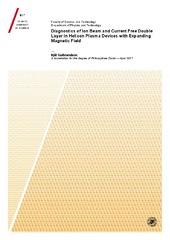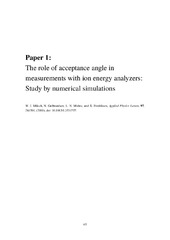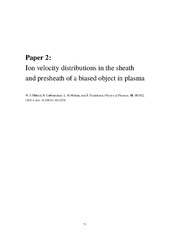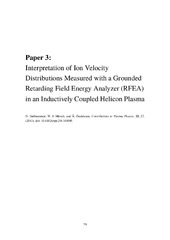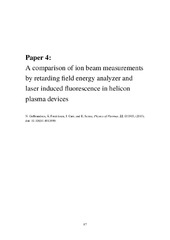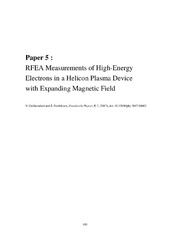| dc.contributor.advisor | Åshild, Fredriksen | |
| dc.contributor.author | Gulbrandsen, Njål | |
| dc.date.accessioned | 2017-10-06T07:51:23Z | |
| dc.date.available | 2017-10-06T07:51:23Z | |
| dc.date.issued | 2017-09-18 | |
| dc.description.abstract | The main focus of this thesis is the diagnostics of ion beams in helicon plasma devices with expanding magnetic field, and running in an inductive mode. These ion beams are closely connected to the concept of current-free double layers (CFDL).
We started by investigating how to best interpret the measurements from a Retarding Field Energy Analyzer (RFEA) through 3-dimensional particle-in-cell simulation. A RFEA will be surrounded by a sheath. The ion distribution function (IDF) measured at the probe will be distorted compared to the IDF in the plasma unaffected by the sheath.
We discovered that the width of the distribution measured by RFEA was larger than expected from 1-dimensional theory. In addition, we found that the low energy part of the distribution was an effect of the probe acceptance angle. Wide acceptance angles give stronger signals at the expense of developing a low energy tail in the IDF. The low energy tails are due to ions entering the aperture at large inclination angles, so that a significant part of their momentum is in the tangential component of the velocity not seen by the probe. Due to the distorted picture of the IDF in the plasma, we found that for the relevant parameter range the RFEA can not provide a reliable ion temperature estimate.
We also found that the maximum (peak) of the IDF is at voltages slightly lower than the plasma potential. This could be associated with the potential drop in the presheath. Thus, the peak of the IDF can be associated with the plasma potential in the close vicinity to the analyzer.
Then we went on to compare RFEA-measurements with Laser Induced Fluorescence (LIF) measurements of ion velocity distribution. While the RFEA-diagnostics is intrusive and will disturb the plasma somewhat, the LIF-diagnostics is none-intrusive. The RFEA measures the ion distribution after it has been accelerated through the sheath surrounding the probe while LIF measures the ion velocity distribution in the plasma itself, without disturbing it. A new method to compare the two techniques is presented. By converting the LIF velocity distribution to an equivalent of a RFEA measurement using a simplified sheath model, we found good agreement between beam energies of the two methods. We also observed that the RFEA is capable of measuring ion beams with densities too low for the LIF to resolve, while the LIF-technique better resolves the back-ground ion distribution. We compare LIF and RFEA measurements in two different helicon plasma devices, the Njord device at the University of Tromsø and the HELIX-LEIA device at West Virginia University.
At last, we apply a RFEA to measure high-energy electrons. By inverting the grid volt-ages, a RFEA can be used to measure electrons. Only electrons with energies high enough to overcome the sheath will reach the probe. Therefore, we would only measure the high-energy part of the electron distribution. | en_US |
| dc.description.doctoraltype | ph.d. | en_US |
| dc.description.popularabstract | In a vacuum chamber, an argon plasma is created using a radio frequency source con-nected to an expansion chamber. Using an expanding magnetic field a potential drop is set up between the source and the expansion chamber. This potential drop, sometimes called a current-free double layer, will accelerate the argon ions toward the expansion chamber where they reach velocities of around 10 km/s. The main focus of this project has been the diagnostics of these ion beams using the two different techniques. The first technique is using gridded electrostatic probes, called Retarding Field Energy Analyz-ers, to measure the kinetic energy and flux of the beam. The second technique is using a laser measurement method called Laser Induced Fluorescence to measure the velocity of the ions. These two types of diagnostics is compared. | en_US |
| dc.description | | en_US |
| dc.identifier.isbn | 978-82-8236-272-6 | |
| dc.identifier.isbn | 978-82-8236-273-3 | |
| dc.identifier.uri | https://hdl.handle.net/10037/11633 | |
| dc.language.iso | eng | en_US |
| dc.publisher | UiT Norges arktiske universitet | en_US |
| dc.publisher | UiT The Arctic University of Norway | en_US |
| dc.rights.accessRights | openAccess | en_US |
| dc.rights.holder | Copyright 2017 The Author(s) | |
| dc.rights.uri | https://creativecommons.org/licenses/by-nc-sa/3.0 | en_US |
| dc.rights | Attribution-NonCommercial-ShareAlike 3.0 Unported (CC BY-NC-SA 3.0) | en_US |
| dc.subject | VDP::Mathematics and natural science: 400::Physics: 430::Space and plasma physics: 437 | en_US |
| dc.subject | VDP::Matematikk og Naturvitenskap: 400::Fysikk: 430::Rom- og plasmafysikk: 437 | en_US |
| dc.title | Diagnostics of Ion Beam and Current Free Double Layer in Helicon Plasma Devices with Expanding Magnetic Field | en_US |
| dc.type | Doctoral thesis | en_US |
| dc.type | Doktorgradsavhandling | en_US |


 English
English norsk
norsk